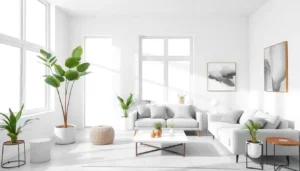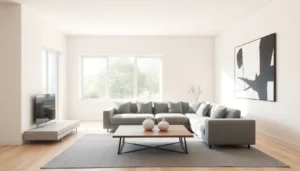Table of Contents
ToggleIn a world overflowing with clutter and chaos, minimalist decor emerges as the stylish superhero we never knew we needed. It’s not just about removing excess; it’s about embracing simplicity and letting your space breathe. Imagine a home where every piece has a purpose, and the only dust bunnies lurking are the ones you choose to ignore.
Minimalism isn’t just a trend; it’s a lifestyle choice that screams sophistication while whispering sweet nothings about tranquility. With its clean lines and intentional design, minimalist decor transforms any space into a serene sanctuary. So why not ditch the knick-knacks and embrace a less-is-more philosophy? After all, who needs a collection of porcelain cats when you can have a chic, open space that makes you feel like a zen master?
What Is Minimalist Decor?
Minimalist decor represents a design philosophy characterized by simplicity. It emphasizes the principle that less is more, focusing on essential elements. This style prioritizes functionality, ensuring that each piece of furniture or decor item fulfills a purpose. Clean lines and neutral color palettes frequently define minimalist spaces, contributing to an uncluttered aesthetic.
Creating a calming environment is central to minimalist decor. Open spaces and natural light enhance the feeling of tranquility, often achieved through strategically placed windows. Furniture typically features simple designs without ornate details, maintaining a cohesive look. Accessories play a minimal role, with a few select pieces chosen for their significance.
A focus on quality over quantity is crucial. This approach encourages selecting high-quality materials that stand the test of time. Textures can vary from soft fabrics to raw woods, adding depth while remaining understated. Each element in a minimalist room complements others, creating a harmonious flow throughout the space.
Minimalist decor promotes mindfulness in both design choices and daily living. Homeowners can curate their environments to reflect personal values and lifestyles. By adopting this decor style, individuals often experience increased mental clarity and reduced stress in their homes. Embracing minimalist principles leads to a more organized and serene living atmosphere.
Key Principles of Minimalist Decor

Minimalist decor revolves around four key principles that shape its unique aesthetic and functionality. Understanding these principles enhances the minimalist experience in any living space.
Simplicity
Simplicity forms the core of minimalist decor. Every item contributes meaningfully, ensuring that unnecessary clutter is absent. Spaces often showcase a few essential pieces, allowing inhabitants to focus on what truly matters. Neutral color palettes dominate, creating a calm atmosphere. Restraint in decorative elements ensures peace reigns in interiors. Clean lines define furniture, enhancing the sense of order while avoiding visual distractions.
Functionality
Functionality is crucial in minimalist design. Each piece of furniture or decor serves a specific purpose, enriching daily life. For instance, multi-functional items maximize utility without overcrowding a space. Thoughtful layouts facilitate ease of movement, allowing occupants to navigate freely. By prioritizing practicality, homeowners create environments where efficiency thrives.
Aesthetic Appeal
Aesthetic appeal blends seamlessly with functionality in minimalist decor. Focus on high-quality materials elevates the overall look while maintaining an understated elegance. Textures such as soft fabrics and natural woods add warmth to otherwise stark environments. Open spaces invite natural light, promoting a bright and inviting atmosphere. Visual harmony among pieces creates a balanced setting that is pleasing to the eye.
Benefits of Minimalist Decor
Minimalist decor offers several advantages that enhance living environments significantly. Two key benefits include enhanced space and reduced stress.
Enhanced Space
Enhanced space is a defining feature of minimalist design. Open layouts feel spacious and inviting, encouraging movement and interaction. Natural light floods interiors, creating a bright ambiance that lifts spirits. By choosing furniture with sleek lines, individuals maximize visual breathing room. Each piece integrates seamlessly, contributing to a harmonious environment. The absence of clutter facilitates organization, making it easier to maintain order. Spatial awareness improves, allowing residents to appreciate their surroundings fully. Minimalist decor showcases how simplicity can transform environments into serene retreats.
Reduced Stress
Reduced stress emerges as another primary benefit of minimalist decor. Calm settings promote relaxation, helping individuals unwind after busy days. Simplified living spaces lessen distractions, fostering mental clarity and focus. Designed thoughtfully, each item within a room has purpose and significance, which encourages mindfulness. Homeowners often feel a sense of calm, created by uncluttered spaces. The intentional use of neutral color palettes also contributes to tranquility. Embracing this style creates environments that promote well-being and a serene mindset. Overall, minimalist decor effectively supports a peaceful lifestyle.
How to Achieve Minimalist Decor
Achieving minimalist decor requires careful consideration of design elements. Each choice contributes to the overall simplicity and serenity of the space.
Choosing the Right Color Palette
Neutral colors dominate minimalist decor. Shades of white, beige, and gray create a calm atmosphere. Selecting soft tones allows for easy integration of various elements. Minimalist spaces benefit from accents of muted pastels to add subtle depth. Choosing a cohesive palette fosters visual harmony throughout the room. Maintaining consistency through walls, furniture, and accessories enhances the uncluttered aesthetic. Resulting in a serene environment, simplicity prevails when vibrant colors are limited.
Essential Furniture Selection
Furniture selection plays a vital role in minimalist design. Choosing pieces with clean lines ensures each item maintains a streamlined look. Opting for multifunctional furniture maximizes space utility, enabling an organized layout. Prioritizing quality over quantity ensures longevity and aesthetic appeal. Minimalist interiors thrive on the presence of fewer, impactful pieces. Stacking or nesting options can save space while providing necessary functionality. Investing in timeless designs ensures harmony and balance within the overall decor.
Tips for Maintaining Minimalist Decor
Prioritize regular decluttering sessions to retain a serene environment. Identify items that no longer serve a purpose and remove them promptly. Establish a routine for assessing belongings, ensuring that every piece in the space has significance.
Opt for multifunctional furniture to enhance utility without adding visual clutter. Pieces like storage ottomans or coffee tables with hidden compartments maximize space while maintaining a clean aesthetic. Focus on selecting designs that offer functionality without sacrificing style.
Choose a neutral color palette to create a cohesive visual flow. Shades such as whites, grays, and beiges promote tranquility, allowing each element to stand out without overwhelming the senses. Incorporate soft tones to maintain harmony and depth within the decor.
Limit decorative accessories to a few carefully chosen items. Select art pieces or plants that align with the minimalist philosophy and enhance the overall atmosphere. Avoid overcrowding surfaces; instead, leave some areas open to emphasize simplicity and calmness.
Ensure that every item within the space reflects quality craftsmanship. Invest in durable materials that withstand the test of time, contributing to a sustainable minimalist approach. Prioritize timeless designs over trends to maintain an enduring aesthetic.
Maintain cleanliness by regularly dusting surfaces and organizing spaces. A tidy environment reinforces the principles of minimalism, allowing for a peaceful living area. Schedule consistent cleaning to prevent accumulation of unnecessary items and clutter.
Incorporate natural light whenever possible to enhance the airy feel of the space. Use sheer window treatments or keep windows unobstructed to maximize brightness. Bright environments foster mental clarity and create an inviting atmosphere conducive to relaxation.
Embracing minimalist decor transforms living spaces into serene retreats that promote tranquility and mindfulness. By focusing on simplicity functionality and quality individuals can create environments that reflect their values while enhancing overall well-being. The principles of minimalist design encourage thoughtful choices that lead to reduced stress and increased mental clarity.
With a commitment to decluttering and selecting impactful pieces homeowners can achieve a harmonious balance that fosters peace. Minimalist decor isn’t just a design choice; it’s a lifestyle that encourages a more organized and fulfilling way of living. Adopting this approach allows for a clearer mind and a more inviting home that truly resonates with the essence of simplicity.










